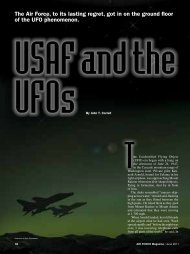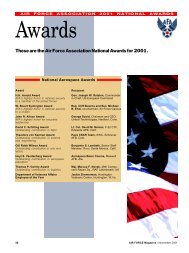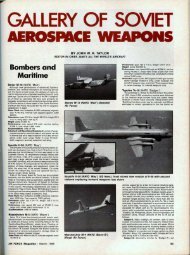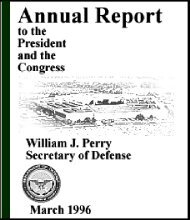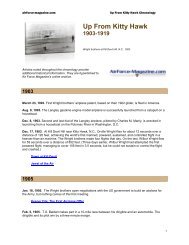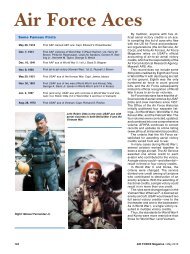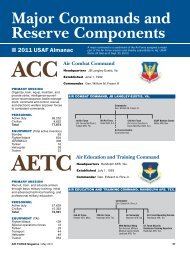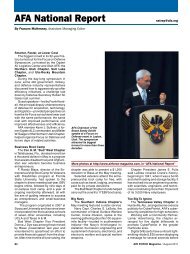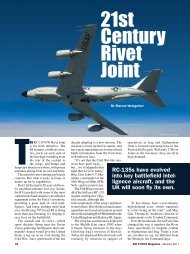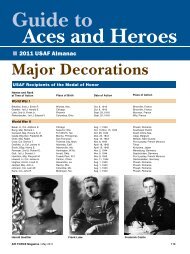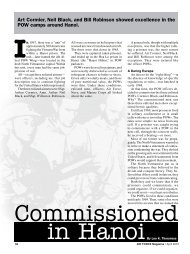1997 Annual Defense Report Table of Contents - Air Force Magazine
1997 Annual Defense Report Table of Contents - Air Force Magazine
1997 Annual Defense Report Table of Contents - Air Force Magazine
You also want an ePaper? Increase the reach of your titles
YUMPU automatically turns print PDFs into web optimized ePapers that Google loves.
anticipated threat forces, and the joint warfighting capability required for each warfighting mission. With<br />
readiness requirements in hand, the Department can allocate resources appropriately.<br />
TRAINING AND EDUCATING READY FORCES<br />
The key to ensuring a trained, ready force in the future is to develop ways to train the force in more<br />
efficient and less costly ways. To that end, the Department is examining both technological improvements<br />
in the training process and outsourcing and privatization efforts projected to provide lower cost <strong>of</strong> training<br />
and education. The Department continues to build upon the Commission on Roles and Missions study<br />
that recommended more outsourcing <strong>of</strong> training and education to provide better individual training at<br />
significantly less cost. Efforts include using the private sector to accelerate the applications <strong>of</strong> advanced<br />
learning technology, and distance learning to produce more efficient and effective training.<br />
Simulation Training<br />
Providing realistic joint training across all phases <strong>of</strong> military operations for all types <strong>of</strong> missions remains<br />
a formidable challenge. Recognizing the need for more such training, the Office <strong>of</strong> the Secretary <strong>of</strong><br />
<strong>Defense</strong>, the Joint Staff, and the Services are coordinating their efforts to create a coherent integrated plan<br />
for the use <strong>of</strong> modeling and simulation in support <strong>of</strong> joint and interservice training.<br />
The Executive Council for Modeling and Simulation established a Training Council for Modeling and<br />
Simulation, chaired by the Deputy Under Secretary <strong>of</strong> <strong>Defense</strong> for Readiness and the Joint Staff Director<br />
for Operational Plans and Interoperability. The primary objective <strong>of</strong> this council is to develop and<br />
implement joint/interservice training simulation plans that represent the needs and interests <strong>of</strong> the training<br />
community. This effort:<br />
• Provides a central focus for coordinating simulation training plans across DoD.<br />
• Provides high-level user requirements to guide DoD research and development efforts.<br />
• Greatly increases the cost-effectiveness <strong>of</strong> DoD investments by eliminating unnecessary<br />
duplication while improving the Services' ability to share common resources.<br />
A major focus <strong>of</strong> the Training Council is the Joint Simulation System (JSIMS) program. In development<br />
for a 1999 introduction, the JSIMS program represents a quantum leap over existing training technology.<br />
It will encompass the full range <strong>of</strong> missions across all phases <strong>of</strong> military operations. JSIMS will provide<br />
better simulations for joint training across the force by using efficient, composable simulations tailored to<br />
meet training needs. It will share a common architecture with other training simulations, as well as<br />
analytical and acquisition related models. Finally, it will interface with actual command, control,<br />
communications, computers, and intelligence (C4I) functions and equipment in the field. DoD has<br />
established a joint program <strong>of</strong>fice for management <strong>of</strong> JSIMS and is in the process <strong>of</strong> providing staffing<br />
from each Service. A new program element has been established for the core JSIMS developments and<br />
efforts are underway to coordinate related Service activities.<br />
The Department has made a priority <strong>of</strong> exploiting enhanced modeling and simulation through distributive<br />
technology. The Department's policy for joint readiness includes proactive application <strong>of</strong> simulation<br />
technologies in the areas <strong>of</strong> joint training, exercises, and readiness monitoring. The coordinated use <strong>of</strong><br />
simulation and C4I systems design will allow for the distribution <strong>of</strong> training support while reducing<br />
training costs. The DoD Modeling and Simulation Master Plan is being amended with a definitive<br />
description <strong>of</strong> the requirements, plans, and programs to support joint and interservice training. In addition,<br />
DoD is pursuing development <strong>of</strong> better modeling methods to improve U.S. capability to predict the<br />
interaction <strong>of</strong> forces and reduce the fog and friction <strong>of</strong> war. This coordinated effort will increase<br />
39


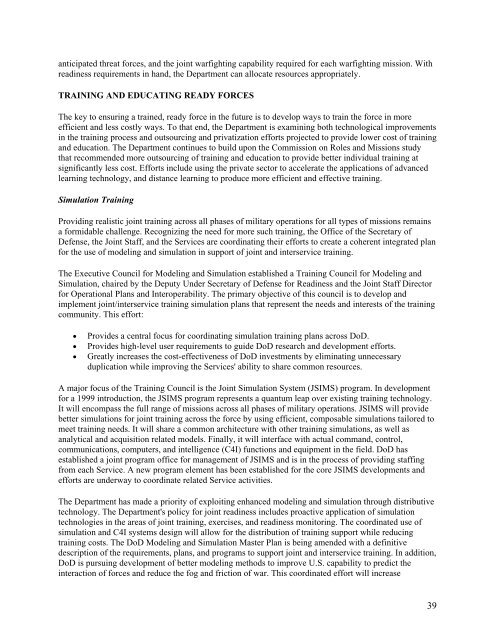
![[PDF] Foulois - Air Force Magazine](https://img.yumpu.com/13391007/1/190x253/pdf-foulois-air-force-magazine.jpg?quality=85)
